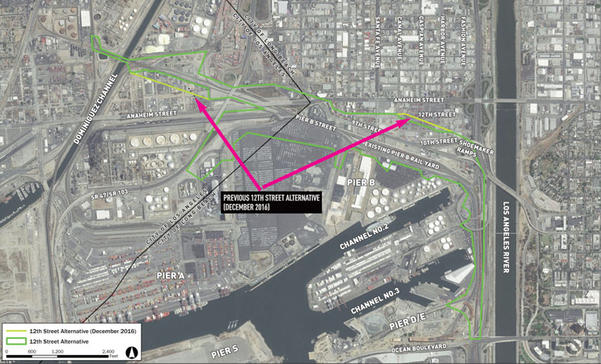The Long Beach Board of Harbor Commissioners approved the Pier B On-Dock Rail Support Facility, a project to expand on-dock rail capacity at the Port of Long Beach, on January 22. The board approved the final environmental impact report (EIR) for the project, selecting the largest possible footprint for the facility outlined in that document. While most public commenters at the meeting spoke in support of the project, Westside business owners emphasized how it would negatively impact their operations.
The Pier B On-Dock Rail Support Facility EIR process began in 2009, when a notice of preparation for the document was released to the public, according to Richard Cameron, managing director of planning and environmental affairs for the port. Since then, port staff has conducted “extensive outreach,” including meetings with property and business owners who would be affected and even displaced by the project, he said at the meeting.

A map pulled from the final environmental impact report (EIR) for the recently approved Pier B On-Dock Rail Facility illustrates changes made from the original draft EIR. Portions of the original project footprint, shown outlined in yellow, were eliminated to reduce impacts to area businesses. Still, 39 parcels may have to be acquired for the project to move forward. (Port of Long Beach image)
The board selected what is referred to as the “12th Street Alternative” – the largest project footprint that extends as far north as 12th Street. On-dock rail at Pier B will be extended to enable longer trains to be assembled and cargo to be placed directly onto rail within terminal gates.
At the meeting, Heather Tomley, the port’s director of environmental planning, stated that each train that leaves the port via on-dock rail could eliminate the need for as many as 750 truck trips. The project is part of a larger initiative by the port to increase the amount of cargo moved by on-dock rail to 35% and is in line with the goals of the recently updated Clean Air Action Plan, Cameron noted.
Many public commenters spoke in support of the project, including several different union representatives who said that it would generate jobs for their members. Leadership and representatives from the Long Beach Area Chamber of Commerce, Long Beach City College, the City of Huntington Beach, Rep. Alan Lowenthal’s office, the Long Beach Fire Department and other entities came out to show their support.
But Westside business owners with operations adjacent to the project expressed dismay. Rail would be built directly next to some businesses, including Superior Electrical Advertising, as its owner, Stan Janocha, pointed out during the public comment period. With clients like Starbucks and Disney, having a rail facility within 125 feet of his property is not an attractive proposition, he explained.
Daryl Phillips, owner of 103-year old business Phillips Steel Co., acknowledged that he was outnumbered by supporters of the project. While he expressed gratitude to port staff for having open lines of communication and acknowledged that it was an important project for the community, he emphasized that the project would negatively impact area businesses.
Phillips noted that the project would disconnect the Westside’s access to the Shoemaker Bridge, which port staff estimated would add an additional four minutes to commute time between the area and Downtown Long Beach. That is a concern for businesses who are worried about the response time by emergency services, Phillips explained.
“In its current size, it truly affects and eliminates way too many businesses, and I would hope that you take an earnest [effort] in understanding our position,” Phillips said. “We know that you’re going to help mitigate, but that doesn’t change the effect, especially with my own employees and all of the other businesses.”
Other businesses would be forced to move or shut down. Thirty-nine parcels – which, as a port spokesperson pointed out, does not equate to as many businesses – may need to be acquired to build the project, according to the EIR. One of those properties encompasses LAN Logistics, a family-owned business at 11th Street that has been located at the site for more than 20 years.
“I am disappointed by the outcome of the vote at the meeting held Monday given that there were other viable options on the table that would have avoided the displacement of my company that’s been located close to the port for decades for a good reason,” LAN Logistics owner John Donaldson told the Business Journal days after the vote. He explained that the cargo the company handles is large and heavy, which necessitates proximity to the port.
Donaldson continued, “Though our location relative to the port is essential to the viability of our business, I am hopeful that the port will work with us to find and/or develop another viable option for relocation and assist with the heavy expenses that come along with the situation we now face to allow us to continue serving our customers, provide stable employment, and improve the local community to the best of our ability.”
During the meeting, Port Executive Director Mario Cordero emphasized that the port remains committed to working with business and property owners who are affected and whose operations may have to be relocated. “The fact is that for this port to remain competitive we need to enhance our rail capability,” Cordero said. “And as you have heard from some of the commentary, clearly enhancing this project is an opportunity to create jobs in the community and support international trade.”
In a recent interview with the Business Journal, Sean Gamette, the port’s managing director of engineering services, pointed out that the final EIR did not include finalized designs for the project, and that there may still be opportunities to mitigate impacts to businesses. He also emphasized that he and his staff are working to create buffer zones along project-adjacent properties, including Superior Electrical Advertising.
